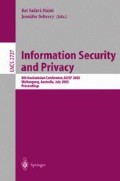Abstract
The RMAC[6] is a variant of CBC-MAC, which resists birthday attacks and gives provably full security. The RMAC uses 2k-bit keys and the size of the RMAC is 2n, where n is the size of underlying block cipher. The TMAC[10] is the improved MAC scheme of XCBC[4] such that it requires (k +n)-bit keys while the XCBC requires (k +2n)-bit keys. In this paper, we introduce trivial key recovery attack on the RMAC with about 2n computations, which is more realistic than the attacks in [9]. Also we give a new attack on the TMAC using about 2n/2+1 texts, which can recover an (k + n)-bit key. However this attack can not be applied to the XCBC. Furthermore we analyzed the IACBC mode[8], which gives confidentiality and message integrity.
Access this chapter
Tax calculation will be finalised at checkout
Purchases are for personal use only
Preview
Unable to display preview. Download preview PDF.
References
M. Bellare, J. Kilian, and P. Rogaway, The Security of the Cipher Block Chaining Message Authentication Code, Advanced in Cryptology — CRYPTO’94, LNCS 839, pp. 341–358, Springer-Verlag, 1994.
A. Berendschot, B. den Boer, J. P. Boly, A. Bosselaers, J. Brandt, D. Chaum, I. Damgård, M. Dichtl, W. Fumy, M. van der Ham, C. J. A. Jansen, P. Landrock, B. Preneel, G. Roelofsen, P. de Rooij, and J. Vandewalle, Integrity Primitives for Secure Information System, Final Report of RACE integrity primitives evaluation (RIPE-RACE 1040), RIPE Integrity Primitives, LNCS 1007, pp. 226, Springer-Verlag, 1995.
E. Biham, How to Decrypt or Even Substitute DES-encrypted message in 228 steps, Information Proceeding Letters, vol. 84, Issue 3, 117–124, Elsevier Science, 15 November, 2002.
J. Black and P. Rogaway, CBC-MACs for Arbitray-Length Messages: The Three Key Constructions, Advanced in Cryptology — CRYPTO 2000, LNCS 1880, pp. 197–215, Springer-Verlag, 2000.
ISO/IEC 9797-1 Information technology — Security techniques — Message Authentication Codes (MACs) — Part I: Mechanisms using a block cipher, International Organization for Standardization, Geneve, Swizerland, 1999.
É. Jaulmes, A. Joux, and F. Valette, On the Security of Randomized CBC-MAC beyond the Birthday Limit: A New Construction, Fast Software Encryption 2002, LNCS 2365, pp. 237–251, Springer-Verlag, 2002.
A. Joux, G. Martinet, and F. Vallete, Blockwise-Adaptive Attackers — Revisiting the (In)Security of Some Provably Secure Encryption Modes: CBC, GEM, IACBC, Advances in Cryptology — CRYPTO 2002, LNCS 2442, pp. 17–30, Springer-Verlag, 2002.
C. S. Jutla, Encryption Modes with Almost Free Message Integrity, Advances in Cryptology — EUROCRYPT 2001, LNCS 2045, pp. 529–544, Springer-Verlag, 2001.
T. Kohno, Key-Collision Attacks against RMAC, The preliminary version published on eprint, October 21, 2002. Available at http://eprint.iacr.org/2002/159/.
K. Kurosawa and T. Iwata, TMAC: Two-Key CBC MAC, Topics in Cryptology-CT-RSA 2003(The Cryptographers Track at the RSA Conference 2003), LNCS 2612, pp. 33–49, Springer-Verlag, 2003. Also available at http://csrc.nist.gov/encryption/modes.
National Bureau of Standards, DES modes of operation, FIPS-Pub.46, National Bureau of Standards, U.S. Department of Commerce, Washington D.C., December 1980.
National Institute of Standards and Technology, AES Mode of Operation Development Effort, Available at http://csrc.nist.gov/encryption/modes.
E. Petrank and C. Rackofff, CBC-MAC for Real Time Data Sources, Journal of Cryptology, vol. 13, no.3, pp. 315–318, 2000.
Author information
Authors and Affiliations
Editor information
Editors and Affiliations
Rights and permissions
Copyright information
© 2003 Springer-Verlag Berlin Heidelberg
About this paper
Cite this paper
Sung, J., Hong, D., Lee, S. (2003). Key Recovery Attacks on the RMAC, TMAC, and IACBC. In: Safavi-Naini, R., Seberry, J. (eds) Information Security and Privacy. ACISP 2003. Lecture Notes in Computer Science, vol 2727. Springer, Berlin, Heidelberg. https://doi.org/10.1007/3-540-45067-X_23
Download citation
DOI: https://doi.org/10.1007/3-540-45067-X_23
Published:
Publisher Name: Springer, Berlin, Heidelberg
Print ISBN: 978-3-540-40515-3
Online ISBN: 978-3-540-45067-2
eBook Packages: Springer Book Archive

